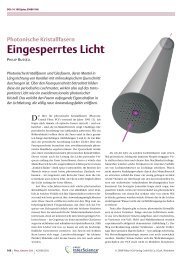Diploma thesis
Diploma thesis
Diploma thesis
You also want an ePaper? Increase the reach of your titles
YUMPU automatically turns print PDFs into web optimized ePapers that Google loves.
plotted in Appendix A.4.3.<br />
Shg power Pump power [a.u.]<br />
30000<br />
25000<br />
20000<br />
15000<br />
10000<br />
5000<br />
Shg spectrum<br />
Pump spectrum<br />
Mapping pump wavelength to shg wavelength<br />
0<br />
700 720 740 760 780 800 820 840<br />
shg wavelength [nm] / pump wavelength [nm/2]<br />
Figure 4.30: Unphasematched SHG<br />
Shg power Pump power [a.u.]<br />
30000<br />
25000<br />
20000<br />
15000<br />
10000<br />
5000<br />
Shg spectrum<br />
Pump spectrum<br />
Mapping pump wavelength to shg wavelength<br />
0<br />
700 720 740 760 780 800 820 840<br />
shg wavelength [nm] / pump wavelength [nm/2]<br />
Figure 4.32: Phasematched SHG<br />
Shg power Pump power [a.u.]<br />
30000<br />
25000<br />
20000<br />
15000<br />
10000<br />
5000<br />
Shg power Pump power [a.u.]<br />
30000<br />
25000<br />
20000<br />
15000<br />
10000<br />
5000<br />
Shg spectrum<br />
Pump spectrum<br />
Shg spectrum<br />
Pump spectrum<br />
Mapping pump wavelength to shg wavelength<br />
0<br />
700 720 740 760 780 800 820 840<br />
shg wavelength [nm] / pump wavelength [nm/2]<br />
Figure 4.31: Shifted SHG<br />
Mapping pump wavelength to shg wavelength<br />
0<br />
700 720 740 760 780 800 820 840<br />
shg wavelength [nm] / pump wavelength [nm/2]<br />
Figure 4.33: Shifted SHG<br />
The result of the power measurements are plotted in Figure 4.34. For each different<br />
pump wavelength, we measured the pump intensity after the waveguide and<br />
the SHG power and calculated the SHG efficiency (Eq. 4.12). To eliminate any<br />
nonlinear effects we always coupled the same amount of pump power through the<br />
waveguide. The phasematching point resides at the peak of the Gaussian distribution.<br />
A Gaussian fit reveals the phasematching point at exactly 1525 nm. This data<br />
shows the equivalence of both approaches. However the measurement of conversion<br />
efficiencies is superior. In the mapping approach we had to manually compare<br />
the different spectra and examine all pictures for an increase in SHG. In the power<br />
approach all data points measured are taken into account and the Gaussian fit to<br />
the power distribution yields much more reliable and exact information about the<br />
phasematching point.<br />
Similar to the first crystal we used this data to fit our model against the experiment.<br />
We had to introduce a kE of -0.01335/µm (Table 4.3), again a fitting vector<br />
in the same order as the grating period. The corrected phasematching functions are<br />
plotted in Figure 4.35 and 4.36, similar to the previous section. The black circle<br />
55



